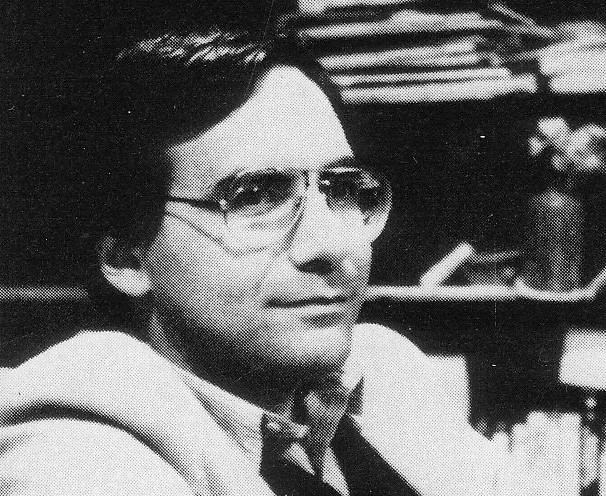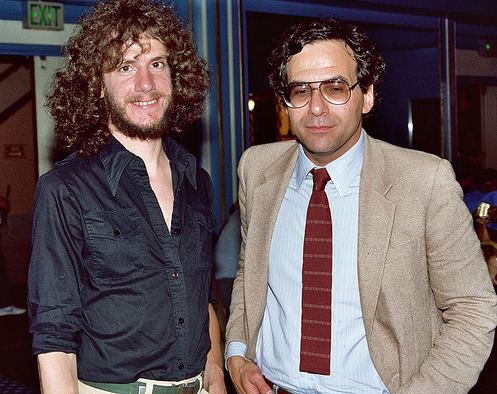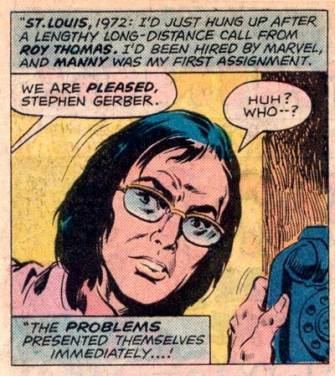Nationality American Role Comic Book Writer Area(s) Writer, Editor Spouse Margo Macleod (m. ?–2008) | Pseudonym(s) Reg Everbest Children Samantha Voll Name Steve Gerber | |
 | ||
Notable works DefendersDoctor FateFoolkillerHard TimeHoward the DuckMan-ThingNevadaOmega the UnknownSludgeTales of the Zombie Awards Eagle Award, 1977Inkpot Award, 1978Will Eisner Comic Book Hall of Fame, 2010 Books Essential Howard The Duck, Stewart the Rat, Nevada Movies and TV shows Howard the Duck, Thundarr the Barbarian, Man‑Thing Similar People | ||
Scott edelman interviews steve gerber 1975
Stephen Ross "Steve" Gerber (September 20, 1947 – February 10, 2008) was an American comic book writer best known as co-creator of the satiric Marvel Comics character Howard the Duck. Other notable works include Man-Thing, Omega the Unknown, Marvel Spotlight: "Son of Satan", The Defenders, Marvel Presents: "Guardians of the Galaxy", Daredevil and "Foolkiller". Gerber was known for including lengthy text pages in the midst of comic book stories, such as in his graphic novel, Stewart the Rat. Gerber was posthumously inducted into the Will Eisner Comic Book Hall of Fame in 2010.
Contents
- Scott edelman interviews steve gerber 1975
- Son of Satan by Gary Friedrich Steve Gerber Jim Mooney COMIC BOOK SYNDICATE
- Early life
- Career
- Man Thing and Howard the Duck
- Battle for Howard the Duck
- Later career
- Death
- In fiction
- Awards and nominations
- References

'Son of Satan' by Gary Friedrich, Steve Gerber & Jim Mooney | COMIC BOOK SYNDICATE
Early life

Steve Gerber was born in St. Louis, Missouri, the son of Bernice Gerber, and one of four children, with siblings Jon, Michael, and Lisa. A letter from Steve Gerber of "7014 Roberts Court, University City 30, Mo." was published in Fantastic Four #19 (Oct. 1963). After corresponding with fellow youthful comics fans Roy Thomas and Jerry Bails, and starting one of the first comics fanzines, Headline, at age 13 or 14, Gerber attended college at the University of Missouri–St. Louis, the University of Missouri in Columbia, Missouri, and St. Louis University, where he finished his communications degree.
Career
Gerber began work as a copywriter for a St. Louis advertising agency. During this time he wrote short stories, some of which, such as "And the Birds Hummed Dirges," later appeared in Crazy Magazine during his stint as editor.

In early 1972, Gerber asked Thomas, by this time Marvel editor-in-chief, about writing comics; Thomas sent him a writer's test – six pages of a Daredevil car-chase scene drawn by Gene Colan – which Gerber passed. He accepted a position as an associate editor and writer at Marvel Comics. Thomas said in 2007,

Steve and I had been in touch, off and on....I [eventually] got a letter from Steve saying, in essence, 'Help! I'm going crazy in this advertising job'....So I thought, 'Gee, he'd be a good person to get up here, so if he wants to make a change, let's give it a try'. He was brought in to be an assistant editor on staff. That didn't work out so well, because for whatever reason ... he had trouble staying awake. At the time, he wasn't a staff kind of person, at least in terms of what Marvel needed, but he was a real good writer and did some interesting things... "
Gerber's comics writing career at Marvel began with three comic books cover dated December 1972: Adventure into Fear #11, The Incredible Hulk #158, and a collaboration with writer Carole Seuling on Shanna the She-Devil. Gerber initially penned superhero stories for titles such as Daredevil (20 issues), Iron Man (three issues), and Sub-Mariner (11 issues). Gerber penned anthological horror-fantasy stories for Creatures on the Loose (adaptations of Lin Carter's Thongor), Monsters Unleashed, Chamber of Chills, and Journey into Mystery, and humor pieces for Crazy Magazine, becoming editor of that satirical magazine for issues #11–14.
Man-Thing and Howard the Duck
Gerber scripted one of his signature series, Man-Thing, about a swamp-monster empath, beginning in Adventure into Fear #11 (Dec. 1972). On page 11 of that issue, he created the series' narrative tagline, used in captions: "Whatever knows fear burns at the Man-Thing's touch!" After issue #19 (Dec. 1973), Man-Thing received a solo title, which ran 22 issues (Jan. 1974 – Oct. 1975). Gerber and Mayerik introduced the original Foolkiller in issue #3 (March 1974). In the final issue, Gerber appeared as a character in the story, claiming he had not been inventing the Man-Thing's adventures but simply reporting on them and that he had decided to move on.
With penciler Val Mayerik, Gerber created Howard the Duck as a secondary character in a Man-Thing story in Adventure into Fear #19 (Dec. 1973). Howard graduated to his own backup feature in Giant-Size Man-Thing, confronting such bizarre horror-parody characters as Bessie the Hellcow and Garko the Man-Frog, before acquiring his own comic-book title with Howard the Duck #1 in January 1976. Gerber wrote 27 issues of the series, penciled initially by Frank Brunner and shortly afterward by Gene Colan. The series gradually developed a substantial cult following, which Marvel helped to promote by Howard's satiric entry into the 1976 U.S. presidential campaign under the auspices of the All-Night Party.
Marvel attempted a spin-off with a short-lived Howard the Duck syndicated comic strip from 1977 to 1978, at first written by Gerber and drawn by Colan and Mayerik, and later written by Marv Wolfman and drawn by Alan Kupperberg. Gerber had been replaced on the strip in mid-1978, creating acrimony and a lawsuit. Marvel's then editor-in-chief, Jim Shooter, blamed Gerber's chronic tardiness, saying the creative team was "producing strips within six days of their publication dates," which he said caused several newspapers to drop the strip. Shooter added that while the syndicate threatened to drop the strip if a new writer were not brought in, "Steve can tell you a good number of horror stories – and they're all true – about the trouble we had getting artists."
Gerber recalled, in the 2000s, that:
We had some problems with the Howard newspaper strip, which led to problems with the Howard book, which ultimately led to the lawsuit. Marvel wouldn't pay the artist to draw it. Gene Colan and I were supposed to get a percentage of the syndicate's take for the strip. The problem was, the money came in 90 days, 120 days, six months – I don't remember how long exactly – after the strips were published. So, essentially, the artist was working for nothing up until that time, and no artist can afford to do that. [In comparison with Stan Lee and John Romita's Spider-Man comic strip,] Stan, as publisher of Marvel, had a regular salary coming in, and John Romita, I believe, was also on staff at the time. They didn't have quite the same problem.
Other series
During this period Gerber often worked with writer Mary Skrenes. Among other Marvel projects, Gerber created Omega The Unknown with Skrenes and artist Jim Mooney, which explored the strange link between a cosmic superhero and a boy, and wrote the first issue of Marvel Comics Super Special featuring the band KISS. He created the characters of Starhawk, Aleta Ogord, and Nikki. He wrote stories of the Son of Satan, Morbius, the Living Vampire and Lilith, Daughter of Dracula.
Gerber often revived forgotten characters. In The Defenders, he brought back three pre-superhero characters, the Headmen. He reintroduced the 1969 one-time feature Guardians of the Galaxy, first as guest stars in Marvel Two-in-One and The Defenders, then as a feature in Marvel Presents.
Toward the end of his work at Marvel, he wrote Hanna-Barbera stories for Mark Evanier under the anagrammatic name Reg Everbest. Only two of these, featuring Magilla Gorilla and Clue Club, were published in their English-language originals.
Battle for Howard the Duck
In the first half of 1978, Gerber was fired from first the newspaper strip and then the comic-book series for a failure to meet deadlines. On August 29, 1980, after learning of Marvel's efforts to license Howard for use in film and broadcast media, Gerber filed a copyright infringement lawsuit against Marvel corporate parent Cadence Industries and other parties, alleging that he was the sole owner of the character.
During the mid 1970s and early 1980s, Gerber did some work for DC Comics, including an issue of Metal Men, the last three issues of Mister Miracle, The Phantom Zone limited series, and a run of "Doctor Fate" backup stories in The Flash co-written with Martin Pasko. Gerber had planned to write for DC's Time Warp science-fiction anthology series but objected to the submission guidelines for that series. Gerber wrote for independent comic companies. One of Gerber's first major works away from Marvel was the original graphic novel Stewart the Rat for Eclipse Comics, with art by Gene Colan and Tom Palmer. For Eclipse Magazine Gerber and Mayerik created the anti-censorship horror story, "Role Model/Caring, Sharing, and Helping Others".
In 1981 he teamed with Jack Kirby at Eclipse to create Destroyer Duck, a satirical comic that raised funds for his court case against Marvel.
The lawsuit was settled on September 24, 1982, with Gerber acknowledging that his work on the character was done as work-for-hire and that Marvel parent Cadence Industries owned “all right, title and interest” to Howard the Duck and the Howard material he had produced. On November 5, 1982, Judge David Kenyon approved the motion and dismissed the case.
Later career
In the early 1980s, Gerber and Frank Miller made a proposal to revamp DC's three biggest characters: Superman, Batman, and Wonder Woman. However, this proposal was not accepted.
Gerber was slated to write a new Spectre series in 1986, but he missed the deadline for the first issue so that he could watch the last day of shooting on the Howard the Duck film, and DC assigned another writer to the series in response.
Gerber wrote various projects for Marvel including Void Indigo for the Epic Comics imprint in 1984, the serialized, eight-page Man-Thing feature in the omnibus series Marvel Comics Presents #1–12 (Sept. 1988 – Feb. 1989), The Legion of Night and Suburban Jersey Ninja She-Devils in 1991 and for DC including A. Bizarro. At Marvel, he had a 12-issue run on The Sensational She-Hulk, a three-issue run on Cloak and Dagger, had Hawkeye get shot and wear a new armored costume designed by Tony Stark in Avengers Spotlight, and wrote two issues of Toxic Crusaders. During this time he did a serial in Marvel Comics Presents featuring Poison, a character he created in "The Evolutionary War" crossover. He wrote the two-issue Freddy Krueger's A Nightmare on Elm Street which delved into the backstory of the character.
In collaboration with Beth Woods (later Slick), he wrote the "Contagion" episode of the syndicated television series Star Trek: The Next Generation.
He worked in television animation, working as story editor on the animated TV series The Transformers, G.I. Joe, and Dungeons & Dragons; created Thundarr the Barbarian; and shared a 1998 Daytime Emmy Award for Outstanding Special Class – Animated Program, for the WB program The New Batman/Superman Adventures.
He was one of the founders of the Malibu Comics Ultraverse, co-creating Sludge and Exiles. For Image Comics, he co-created The Cybernary with Nick Manabat and disbanded Codename: Strykeforce, in addition to guest-writing Pitt. In 2002 he created a new Howard the Duck mini-series for Marvel's MAX line. For DC he created Nevada for the Vertigo imprint in 1998 with artist Phil Winslade and Hard Time with long-time collaborator Mary Skrenes, which outlasted the short-lived imprint DC Focus, but slow sales led Hard Time: Season Two to be cancelled after only seven issues.
Later, Gerber wrote the Helmet of Fate: Zauriel one-shot and continued writing the Doctor Fate serial in the Countdown to Mystery limited series for DC Comics up to the time of his death, working on stories in the hospital. Gerber died before being able to write the concluding chapter of the serial; in his honor, four separate writers (Adam Beechen, Mark Evanier, Gail Simone, and Mark Waid) provided their own conclusions to the story.
In 2010, Comics Bulletin ranked Gerber's run on The Defenders first on its list of the "Top 10 1970s Marvels" while Omega the Unknown was tenth on the same list.
Gerber's posthumous Man-Thing story "The Screenplay of the Living Dead Man", with art by Kevin Nowlan, originally planned as a 1980s graphic novel before being left uncompleted by the artist, was revived in the 2010s and appeared as a three-issue miniseries cover-titled The Infernal Man-Thing (early Sept.-Oct. 2012). The story was a sequel to Gerber's "Song-Cry of the Living Dead Man" in Man-Thing #12 (Dec. 1974).
Death
In 2007, Gerber was diagnosed with an early stage of idiopathic pulmonary fibrosis, and was eventually hospitalized while continuing to work. He had gotten onto the waiting list for a lung transplant at UCLA Medical Center. On February 10, 2008, Gerber died in a Las Vegas hospital from complications stemming from his condition. His final comics work was writing Countdown to Mystery: Doctor Fate for DC Comics, having briefly worked with a version of the character in 1983.
At the time of his death, Gerber was separated from his wife, Margo Macleod. He had a daughter, Samantha Voll.
In fiction
One of Gerber's working pen-names, Reg Everbest, was the inspiration behind the first Foolkiller's real name which was revealed as Ross G. Everbest. Gerber used the anagrammatic Reg Everbest pseudonym for Marvel-published Hanna-Barbera stories after he was banned from Marvel by Jim Shooter. Roger Stern named the original, deceased Foolkiller "Ross G. Everbest" in The Amazing Spider-Man #225, in homage to Gerber, using Gerber's middle name as the character's first name, the middle initial restoring the anagram save for a silent e. The character's real name never appeared in the two Gerber stories, but is seen on a computer screen in the second Foolkiller's van, next to the face of the original user of that identity.
